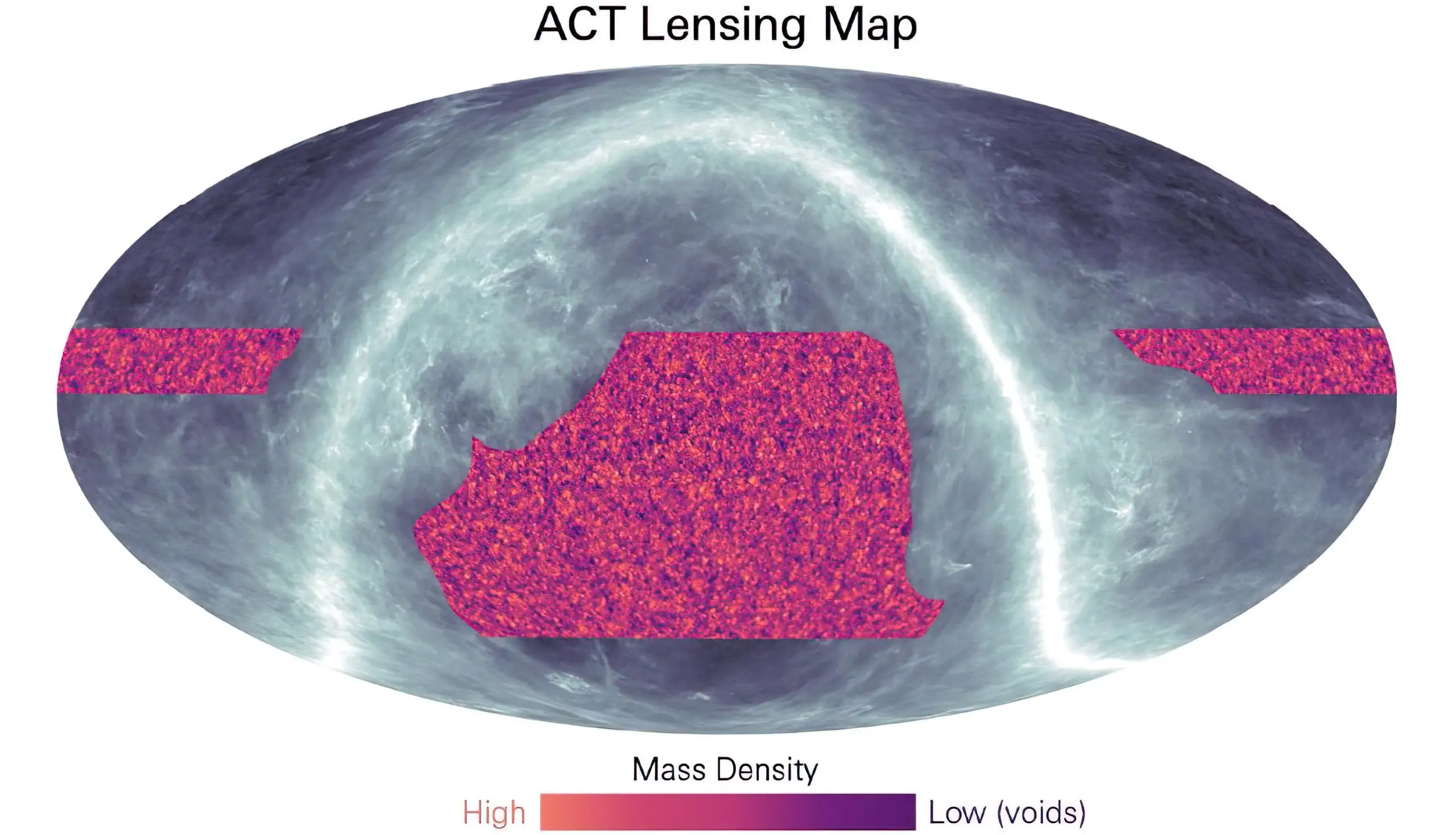Onderzoekers gebruikten de Atacama Cosmology Telescope om deze nieuwe kaart van donkere materie te maken. Oranje gebieden geven aan waar meer massa is; Magenta waar er minder of geen is. Typische kenmerken omspannen honderden miljoenen lichtjaren. De witachtige band die aangeeft waar licht wordt verduisterd door stof in onze Melkweg, gemeten door de Planck-satelliet, geeft een dieper beeld. De nieuwe kaart gebruikt voornamelijk licht van de kosmische microgolfachtergrond (CMB) als achtergrondlicht om alles tussen ons en de oerknal weer te geven. “Het lijkt een beetje op schaduwen, maar in plaats van alleen zwart in het silhouet te hebben, heb je textuur en klonten donkere materie, alsof het licht door een stoffen gordijn stroomt met veel knopen en bobbels”, zegt Susan Staggs. Henry D. Wolfe Smith hoogleraar natuurkunde aan Princeton University. “Het beroemde blauw-en-gele CMB-beeld is een momentopname van hoe het universum eruit zag in een bepaald tijdperk, ongeveer 13 miljard jaar geleden, en dat geeft ons nu informatie over alle tijdperken sindsdien.” Krediet: ACT-samenwerking
Onderzoek door de Atacama Cosmology Telescope-samenwerking mondde uit in een grote doorbraak in het begrijpen van de evolutie van het universum.
Al duizenden jaren zijn mensen gefascineerd door de mysteries van het universum.
In tegenstelling tot filosofen uit de oudheid die zich de oorsprong van het universum voorstelden, gebruiken moderne kosmologen kwantitatieve hulpmiddelen om inzicht te krijgen in de evolutie en structuur van het universum. Moderne kosmologie dateert uit het begin van de 20e eeuw, met de ontwikkeling van de algemene relativiteitstheorie van Albert Einstein.
Nu hebben onderzoekers van de Atacama Cosmology Telescope (ACT) Collaboration een reeks papers ingediend bij de de[{” attribute=””>Astrophysical Journal featuring a groundbreaking new map of dark matter distributed across a quarter of the sky, extending deep into the cosmos, that confirms Einstein’s theory of how massive structures grow and bend light over the 14-billion-year life span of the universe.
The new map uses light from the cosmic microwave background (CMB) essentially as a backlight to silhouette all the matter between us and the Big Bang.

The Atacama Cosmology Telescope in Northern Chile, supported by the National Science Foundation, operated from 2007-2022. The project is led by Princeton University and the University of Pennsylvania — Director Suzanne Staggs at Princeton, Deputy Director Mark Devlin at Penn — with 160 collaborators at 47 institutions. Credit: Mark Devlin, Deputy Director of the Atacama Cosmology Telescope and the Reese Flower Professor of Astronomy at the University of Pennsylvania
“It’s a bit like silhouetting, but instead of just having black in the silhouette, you have texture and lumps of dark matter, as if the light were streaming through a fabric curtain that had lots of knots and bumps in it,” said Suzanne Staggs, director of ACT and Henry DeWolf Smyth Professor of Physics at Princeton University. “The famous blue and yellow CMB image [from 2003] Het is een momentopname van hoe het universum eruit zag in één tijdperk, ongeveer 13 miljard jaar geleden, en dat geeft ons nu informatie over alle tijdperken die sindsdien zijn verstreken.”
“Het is opwindend om in het onzichtbare te kunnen kijken en om de steigers van donkere materie te onthullen die onze zichtbare sterrenstelsels ondersteunen”, vertelde Joe Dunkley, professor in de natuurkunde en astrofysische wetenschappen die de analyse leidt, aan ACT. “In dit nieuwe beeld kunnen we uit de eerste hand het onzichtbare kosmische web van donkere materie zien dat sterrenstelsels omringt en verbindt.”
“Normaal gesproken kunnen astronomen alleen licht meten, dus we zien hoe sterrenstelsels over het universum zijn verdeeld. Deze waarnemingen onthullen de verdeling van massa, dus ze laten vooral zien hoe donkere materie over ons universum is verdeeld”, zegt David Spergel, een professor in de astronomie aan Princeton University, Charles a. .

Het onderzoek door de Atacama Cosmology Telescope-samenwerking heeft geresulteerd in een baanbrekende nieuwe kaart van donkere materie die een kwart van de hele hemel beslaat en tot diep in het universum reikt. De resultaten bieden verdere ondersteuning voor de algemene relativiteitstheorie van Einstein, die al meer dan een eeuw de basis vormt van het standaardmodel van de kosmologie, en bieden nieuwe manieren om donkere materie te demystificeren. Credits: Lucy Reading-Ikkanda, Simons Foundation
“We hebben de verdeling van onzichtbare donkere materie aan de hemel in kaart gebracht, en dat is precies zoals voorspeld door onze theorieën”, zegt co-auteur Blake Sherwin, PhD, 2013. Afgestudeerd aan Princeton University en hoogleraar Kosmologie aan de Universiteit van Cambridge, waar hij een grote groep ACT-onderzoekers leidt. “Dit is verbazingwekkend bewijs dat we het verhaal van hoe de structuur in ons universum gedurende miljarden jaren is gevormd, nog steeds begrijpen[{” attribute=””>Big Bang to today.’
He added: “Remarkably, 80% of the mass in the universe is invisible. By mapping the dark matter distribution across the sky to the largest distances, our ACT lensing measurements allow us to clearly see this invisible world.”
“When we proposed this experiment in 2003, we had no idea the full extent of information that could be extracted from our telescope,” said Mark Devlin, the Reese Flower Professor of Astronomy at the University of Pennsylvania and the deputy director of ACT, who was a Princeton postdoc from 1994-1995. “We owe this to the cleverness of the theorists, the many people who built new instruments to make our telescope more sensitive, and the new analysis techniques our team came up with.” This includes a sophisticated new model of ACT’s instrument noise by Princeton graduate student Zach Atkins.

Research by the Atacama Cosmology Telescope collaboration has culminated in a groundbreaking new map of dark matter distributed across a quarter of the entire sky, reaching deep into the cosmos. Findings provide further support to Einstein’s theory of general relativity, which has been the foundation of the standard model of cosmology for more than a century, and offer new methods to demystify dark matter. Credit: Image courtesy of Debra Kellner
Despite making up most of the universe, dark matter has been hard to detect because it doesn’t interact with light or other forms of electromagnetic radiation. As far as we know, dark matter only interacts with gravity.
To track it down, the more than 160 collaborators who have built and gathered data from the National Science Foundation’s Atacama Cosmology Telescope in the high Chilean Andes observed light emanating following the dawn of the universe’s formation, the Big Bang — when the universe was only 380,000 years old. Cosmologists often refer to this diffuse CMB light that fills our entire universe as the “baby picture of the universe.”
The team tracked how the gravitational pull of massive dark matter structures can warp the CMB on its 14-billion-year journey to us, just as antique, lumpy windows bend and distort what we can see through them.
“We’ve made a new mass map using distortions of light left over from the Big Bang,” said Mathew Madhavacheril, a 2016-2018 Princeton postdoc who is the lead author of one of the papers and an assistant professor in physics and astronomy at the University of Pennsylvania. “Remarkably, it provides measurements that show that both the ‘lumpiness’ of the universe, and the rate at which it is growing after 14 billion years of evolution, are just what you’d expect from our standard model of cosmology based on Einstein’s theory of gravity.”
Sherwin added, “Our results also provide new insights into an ongoing debate some have called ‘The Crisis in Cosmology.’” This “crisis” stems from recent measurements that use a different background light, one emitted from stars in galaxies rather than the CMB. These have produced results that suggest the dark matter was not lumpy enough under the standard model of cosmology and led to concerns that the model may be broken. However, the ACT team’s latest results precisely assessed that the vast lumps seen in this image are the exact right size.
“While earlier studies pointed to cracks in the standard cosmological model, our findings provide new reassurance that our fundamental theory of the universe holds true,” said Frank Qu, lead author of one of the papers and a Cambridge graduate student as well as a former Princeton visiting researcher.
“The CMB is famous already for its unparalleled measurements of the primordial state of the universe, so these lensing maps, describing its subsequent evolution, are almost an embarrassment of riches,” said Staggs, whose team built the detectors that gathered this data over the past five years. “We now have a second, very primordial map of the universe. Instead of a ‘crisis,’ I think we have an extraordinary opportunity to use these different data sets together. Our map includes all of the dark matter, going back to the Big Bang, and the other maps are looking back about 9 billion years, giving us a layer that is much closer to us. We can compare the two to learn about the growth of structures in the universe. I think is going to turn out to be really interesting. That the two approaches are getting different measurements is fascinating.”
ACT, which operated for 15 years, was decommissioned in September 2022. Nevertheless, more papers presenting results from the final set of observations are expected to be submitted soon, and the Simons Observatory will conduct future observations at the same site, with a new telescope slated to begin operations in 2024. This new instrument will be capable of mapping the sky almost 10 times faster than ACT.
Of the co-authors on the ACT team’s series of papers, 56 are or have been Princeton researchers. More than 20 scientists who were junior researchers on ACT while at Princeton are now faculty or staff scientists themselves. Lyman Page, Princeton’s James S. McDonnell Distinguished University Professor in Physics, was the former principal investigator of ACT.
This research will be presented at “Future Science with CMB x LSS,” a conference running from April 10-14 at Yukawa Institute for Theoretical Physics, Kyoto University. The pre-print articles highlighted here will appear on the open-access arXiv.org. They have been submitted to the Astrophysical Journal. This work was supported by the U.S. National Science Foundation (AST-0408698, AST-0965625 and AST-1440226 for the ACT project, as well as awards PHY-0355328, PHY-0855887 and PHY-1214379), Princeton University, the University of Pennsylvania, and a Canada Foundation for Innovation award. Team members at the University of Cambridge were supported by the European Research Council.

“Amateur-organisator. Wannabe-bierevangelist. Algemene webfan. Gecertificeerde internetninja. Fanatieke lezer.”










More Stories
SpaceX lanceert 23 Starlink-satellieten op Falcon 9-vlucht vanuit Cape Canaveral – Spaceflight Now
Het omzetten van onzichtbare donkere materie in zichtbaar licht
Een ongekende meteorietontdekking daagt astrofysische modellen uit